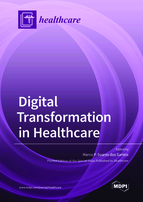Digital Transformation in Healthcare
A special issue of Healthcare (ISSN 2227-9032). This special issue belongs to the section "Artificial Intelligence in Medicine".
Deadline for manuscript submissions: closed (15 December 2021) | Viewed by 62685
Special Issue Editor
Interests: bioelectronic implants; sensors for medical devices; biophysical stimulation of biological tissues; energy harvesting to power intracorporeal medical devices
Special Issues, Collections and Topics in MDPI journals
Special Issue Information
Dear Colleagues,
This issue aims to provide a revealing overview of the impact of advanced computation and instrumentation on healthcare. A worldwide increasing trend is driving innovation for a new era of multifunctional technologies with the ability to autonomously perform intensive therapeutic actuation, physiologic monitoring, digital processing, and communication operations. Products and services are being researched to increasingly incorporate computational capabilities. Research on healthcare is nowadays performed on a multidisciplinary basis, comprising computational engineering, biomedicine, biomedical engineering, electronic engineering, and automation engineering, among other areas. This Special Issue aims to disseminate cutting-edge research focused on ten topics: (1) personalized healthcare; (2) big data in healthcare; (3) predictive healthcare; (4) virtual reality in healthcare; (5) telemedicine; (6) artificial intelligence in healthcare; (7) bioelectronic medicine; (8) innovative medical devices—wearable medical devices and bioelectronic/instrumented implants; (9) modelling and simulation in healthcare; (10) energy harvesting to power medical devices. This interdisciplinary forum encourages the submission of original research, reviews, short reports, and opinion papers.
Dr. Marco P. Soares dos Santos
Guest Editor
Manuscript Submission Information
Manuscripts should be submitted online at www.mdpi.com by registering and logging in to this website. Once you are registered, click here to go to the submission form. Manuscripts can be submitted until the deadline. All submissions that pass pre-check are peer-reviewed. Accepted papers will be published continuously in the journal (as soon as accepted) and will be listed together on the special issue website. Research articles, review articles as well as short communications are invited. For planned papers, a title and short abstract (about 100 words) can be sent to the Editorial Office for announcement on this website.
Submitted manuscripts should not have been published previously, nor be under consideration for publication elsewhere (except conference proceedings papers). All manuscripts are thoroughly refereed through a single-blind peer-review process. A guide for authors and other relevant information for submission of manuscripts is available on the Instructions for Authors page. Healthcare is an international peer-reviewed open access semimonthly journal published by MDPI.
Please visit the Instructions for Authors page before submitting a manuscript. The Article Processing Charge (APC) for publication in this open access journal is 2700 CHF (Swiss Francs). Submitted papers should be well formatted and use good English. Authors may use MDPI's English editing service prior to publication or during author revisions.
Keywords
- Personalized healthcare
- Big data in healthcare
- Predictive healthcare
- Virtual reality in healthcare
- Modelling and simulation
- Bioelectronic medicine
- Telemedicine
- Artificial intelligence
- Medical devices
- Energy harvesting







